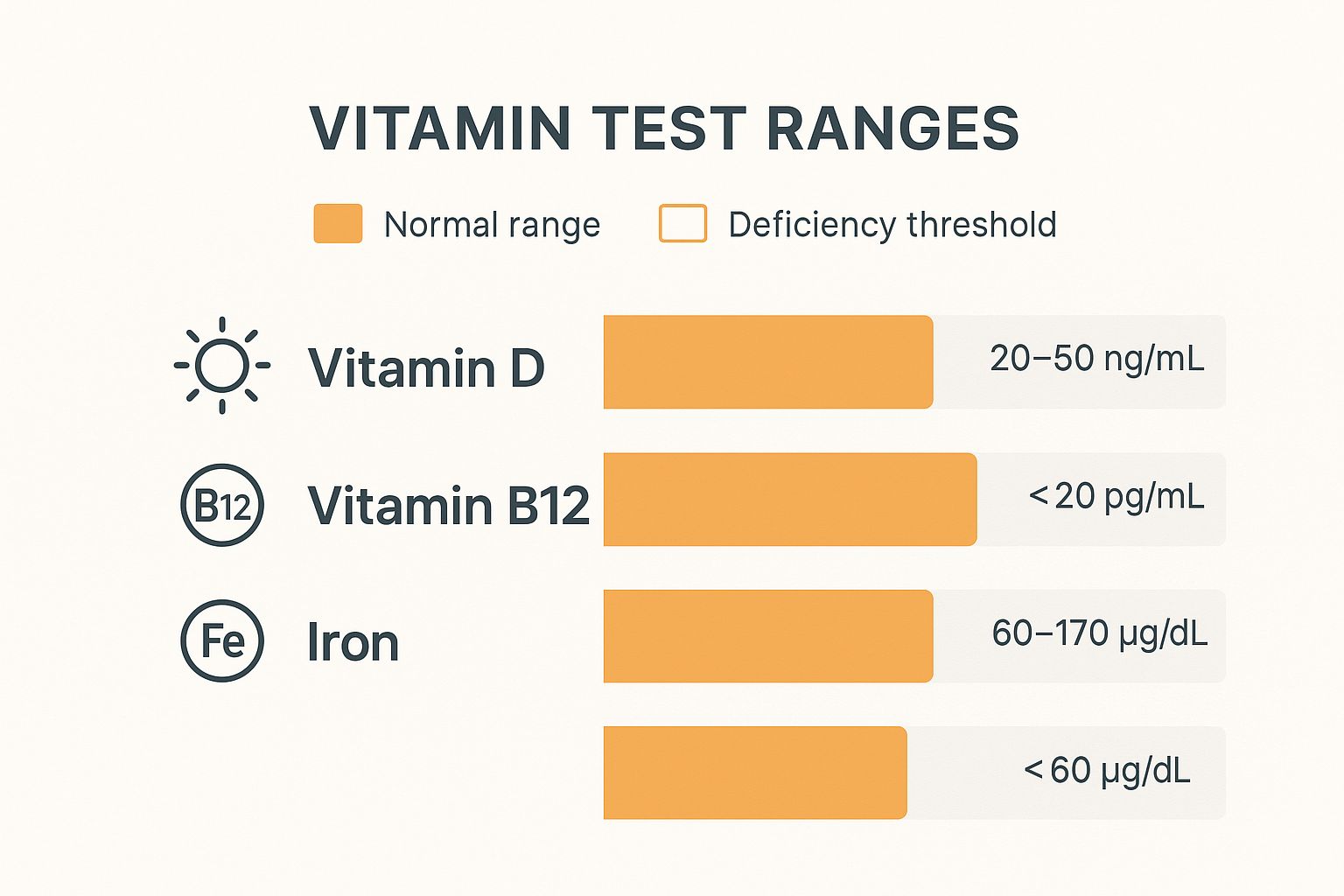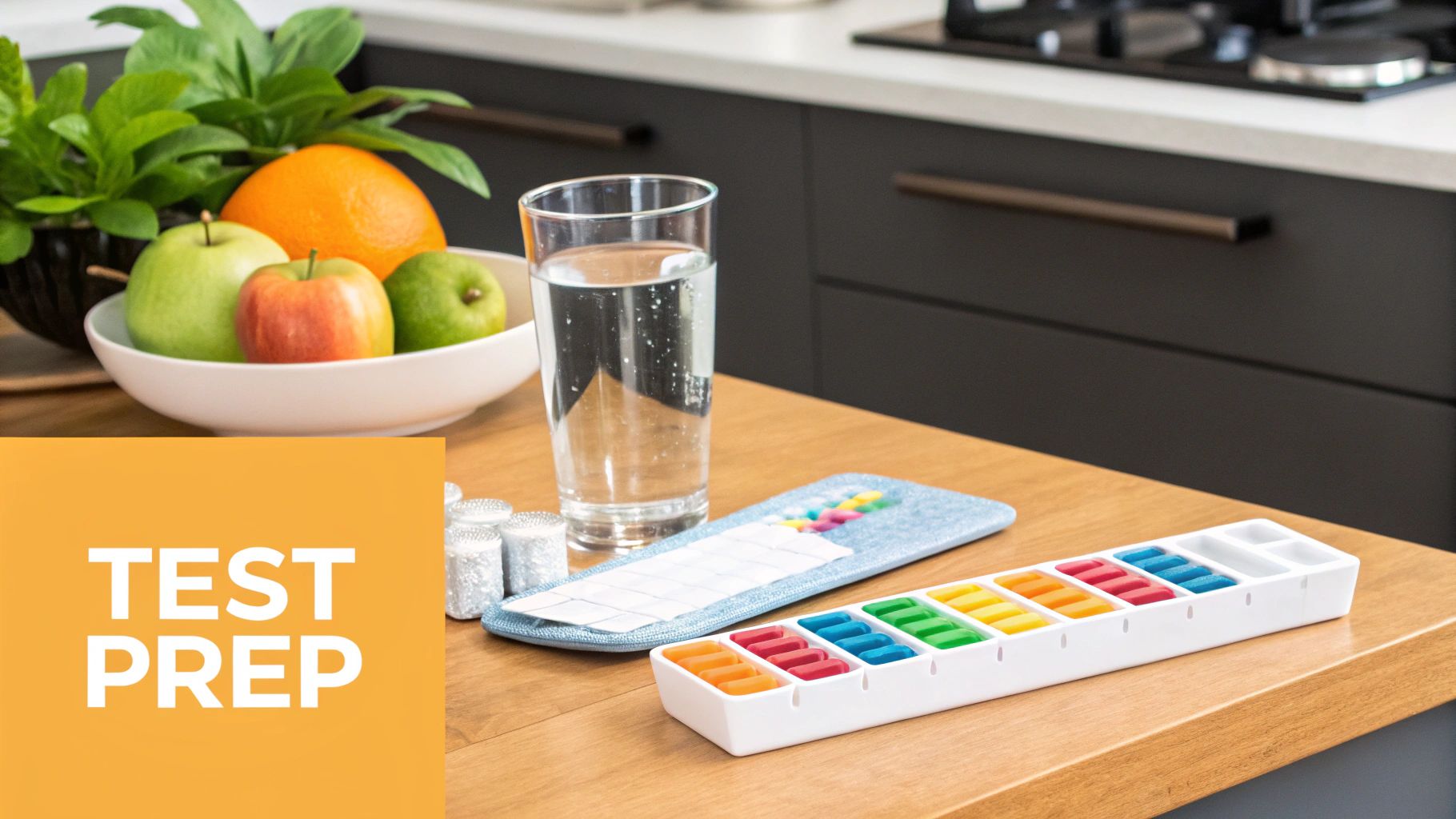Feeling tired, foggy, or just a little bit off all the time? It’s easy to write that off as just a side effect of modern life, but those nagging feelings could be your body’s way of telling you it's running low on fuel. This is what experts call “hidden hunger”—a lack of the essential vitamins your body needs to truly function at its best. Testing for vitamin deficiency is the first real step to uncovering the root cause and getting your energy back.
Why Vitamin Deficiency Testing Matters Now

You’d think that with access to so much food, we’d all be getting the nutrients we need. But the reality is much more complicated. Our modern food supply, while plentiful, doesn’t always deliver on nutrient density. This has created a widespread problem that affects millions of people, even in developed countries.
The issue is so common that global health experts have given it a name: 'hidden hunger.' This isn't about the amount of food on your plate; it’s about the quality and variety of nutrients you're actually absorbing. In fact, some studies show that more than half of the world's population doesn't get enough critical micronutrients like iron and key vitamins. You can read more about these global health findings from Harvard to see just how big this problem is.
Connecting Symptoms to a Solvable Problem
That constant fatigue, brain fog, and the feeling that you’re always catching the latest bug—we often just accept these as part of a busy life. But what if they aren't? These are classic signs that your body might be running on empty.
Think of your body as a high-performance engine. Vitamins are the specialized oils and additives that keep everything running smoothly. Without them, the engine sputters, loses power, and eventually wears down.
This is exactly why getting a clear picture of your nutrient levels is so important. It takes those vague, frustrating symptoms and turns them into solid, actionable data. Instead of just guessing what’s wrong, testing for a vitamin deficiency gives you a personalized roadmap of what your body is actually missing.
This knowledge puts you in the driver's seat, allowing you to:
- Pinpoint specific shortfalls: Find out exactly which vitamins are low, whether it’s B12, D, iron, or something else.
- Have informed conversations: Walk into your doctor's office with real data, not just a list of hard-to-explain symptoms.
- Create a targeted plan: Move beyond shooting in the dark with generic multivitamins and start addressing your unique needs with precision.
Ultimately, testing is the bridge between feeling unwell and having a concrete plan to get better. It’s the essential first step toward reclaiming your energy and feeling like yourself again.
Decoding Your Body's Subtle Warning Signs

Your body rarely goes from feeling great to unwell overnight. Instead, it sends out quiet signals—subtle warnings that something is out of balance. Learning to interpret these clues is the first step toward understanding whether you need testing for vitamin deficiency.
Think of these symptoms as your body trying to communicate with you. That persistent fatigue you've been blaming on a busy schedule could actually be your body’s way of signaling low B12 or iron. Brittle nails and thinning hair aren't just cosmetic annoyances; they can be direct pointers to a lack of biotin. These aren't random issues but valuable pieces of data.
The problem is, these signs are easy to dismiss or misinterpret because they often overlap. A small crack at the corner of your mouth seems minor, but it’s a classic indicator of a riboflavin (B2) or iron shortfall. When you learn to spot these patterns, you can have a much more productive conversation with your doctor.
Common Signs And Potential Deficiencies
It’s helpful to connect specific symptoms to the vitamins that might be in short supply. While this is far from a diagnostic tool, it can help you see patterns that are worth a closer look.
- Persistent Fatigue and Weakness: This is one of the most common complaints for a reason. It can be linked to several deficiencies, most notably Iron, Vitamin B12, and Vitamin D.
- Brittle Hair and Nails: If your hair and nails seem to break just by looking at them, it could point to a deficiency in Biotin (B7), which is essential for producing the protein keratin.
- Cracks at the Corners of the Mouth: Known clinically as angular cheilitis, this is frequently associated with low levels of Iron and B vitamins, especially Riboflavin (B2).
- Poor Night Vision or Dry Eyes: Your eyes rely heavily on Vitamin A. A deficiency can show up as difficulty seeing in low light or having unusually dry eyes.
This symptom-focused approach turns you from a passive patient into an active partner in your health. You're no longer just listing off complaints; you're presenting evidence that points toward a potential need for vitamin deficiency testing.
A Global Health Concern
This isn't just an individual struggle; it's a massive global health issue. The scale of this "hidden hunger" is staggering, especially for the world's most vulnerable. Recent findings show that approximately 50% of preschool-aged children and 67% of women of reproductive age worldwide suffer from vitamin and mineral deficiencies. This data drives home why recognizing symptoms and seeking testing is so critical. You can explore the full scope of these new global hidden hunger estimates to grasp the worldwide impact.
By paying close attention to your body’s signals—from your energy levels to the health of your skin and hair—you gather the information needed to decide if testing for vitamin deficiency is the logical next step. It’s about being proactive and turning those subtle clues into a clear action plan for better health.
A Guide to Vitamin Deficiency Tests
Trying to figure out which test to take for a possible vitamin deficiency can feel overwhelming, but it doesn't have to be. Think of it like deciding which tool to use on your car's engine: a quick look at the dipstick gives you a fast overview, while a full diagnostic from a mechanic provides precise, detailed information. Knowing what your options are is the first step to making a smart decision.
You really have two main paths for testing for vitamin deficiency: the traditional lab-based blood tests and the newer at-home testing kits. Each one has a specific job and its own set of pros and cons.
Traditional Lab Testing
A blood test ordered by your doctor is the gold standard when it comes to accuracy. This is the classic approach where a blood draw is done at a clinic or lab, and the sample is professionally analyzed for specific nutrient levels. Your doctor will usually recommend this based on your symptoms, medical history, and any risk factors they've identified.
The biggest advantage here is professional oversight. A healthcare provider doesn’t just make sure the test is done right; they interpret the results in the full context of your health. They can tell you the difference between a "normal" range and what's truly "optimal" for you.
At-Home Vitamin Testing Kits
For sheer convenience, at-home kits have become a very popular choice. These usually require a simple finger-prick blood sample that you collect yourself and then mail to a certified lab. They offer a level of privacy and accessibility that lets you take that first step from the comfort of your own home.
While kits from reputable companies can be reliable, it's best to think of them as a screening tool. The results give you a valuable snapshot, but it's absolutely crucial to talk about any concerning findings with a doctor. They can help confirm what the kit shows and build a safe, effective plan to address any nutrient shortfalls.
Key Takeaway: A doctor-ordered blood test gives you diagnostic precision and professional interpretation, while at-home kits offer a convenient way to get an initial look. The best choice really depends on what you need—whether you're trying to figure out the cause of specific symptoms or are just curious about your baseline levels.
To help you understand your options at a glance, this table compares the key features of the most common methods for vitamin deficiency testing.
Comparing Common Methods for Vitamin Deficiency Testing
This table compares the key features of different vitamin testing methods to help you understand your options.
| Test Method | What It Measures | Common Use Case | Pros | Cons |
|---|---|---|---|---|
| Doctor-Ordered Blood Test | Specific vitamin levels in blood serum or plasma. | Diagnosing a deficiency based on symptoms, medical history, or risk factors. | Highest accuracy and reliability; results interpreted by a medical professional; often covered by insurance. | Requires a doctor's visit and a trip to a lab; can be more expensive if not covered by insurance. |
| At-Home Finger-Prick Test | A panel of common vitamin levels from a dried blood spot. | General wellness screening; monitoring known levels; initial curiosity about nutritional status. | Convenient and can be done from home; offers privacy; often less expensive for a broad panel. | Less accurate than a full blood draw; results lack professional context; risk of user error during collection. |
Ultimately, whether you start with an at-home kit or go straight to your doctor, the goal is the same: to get clear, actionable information about your health.
It's an unfortunate reality that modern lifestyles have made deficiencies more common. Research has shown that factors like smoking and nutrient-poor diets have caused a spike in vitamin D and A deficiencies. The vitamin test panels used to find these issues are highly advanced, often using methods like liquid chromatography to analyze levels of B vitamins, A, E, K, and folic acid.
This infographic gives you a clear visual for the thresholds between normal and deficient levels for a few key nutrients.

As the chart shows, there isn't much of a gray area; once your levels dip below the established threshold, a deficiency is confirmed.
Once a deficiency is confirmed, a targeted treatment plan is essential. For those with significant shortfalls or absorption issues, a doctor might recommend more direct approaches. To understand how these treatments work, you can explore our guide on injectable vitamins for humans. This ensures your body receives the nutrients it needs to restore optimal health.
How to Prepare for Your Vitamin Test

To get a truly accurate picture of your body's nutrient status, what you do before your testing for vitamin deficiency is everything. A little preparation ensures the results reflect your actual health, not just what you had for breakfast. Skipping these steps can lead to skewed results, meaning you might have to go through the frustration and expense of a re-test.
Your doctor will give you specific instructions, but a few general rules apply to most vitamin panels. Fasting is one of the most common requirements. This usually means no food or drinks (other than water) for about 8 to 12 hours before your blood draw. This simple step prevents recently eaten foods from temporarily—and inaccurately—spiking your nutrient levels.
Think of it like checking the oil in your car. You wouldn't do it right after topping it off, because you wouldn't get a true reading. Fasting gives your body time to level out, providing a clean, stable baseline of your nutrient stores.
Managing Your Supplements and Medications
This part is absolutely critical. You need to be completely transparent with your provider about every single supplement you take, as some can directly interfere with your lab results. Bring a complete list of everything, from your daily multivitamin to any herbal remedies.
The most notorious offender here is biotin (Vitamin B7), which is a popular ingredient in supplements for hair, skin, and nails. High doses of biotin can throw off the results for several key markers, sometimes causing falsely high or low readings for things like thyroid hormones or even certain heart tests.
Your doctor will almost certainly ask you to stop taking certain supplements for a few days before your test. Make sure you follow their instructions to the letter.
Communicate Clearly With Your Provider
Your lab results are just one piece of a much larger puzzle. For your doctor to interpret them correctly, they need context about your life and habits. Be prepared to have an honest conversation about:
- Your typical diet: What do you eat on a regular day?
- Lifestyle factors: Don't hold back on details about your sleep, stress levels, or alcohol intake.
- Current medications: Provide a full list of all prescriptions and over-the-counter drugs.
- Symptom history: Describe any signs or symptoms that made you want to get tested in the first place.
This complete picture helps your doctor connect the dots between the numbers on the page and what's really happening in your body. Finally, remember that when you take your supplements can also affect your long-term levels. You can learn more about creating an effective schedule in our guide on the best time to take vitamins.
Making Sense of Your Test Results
Getting a lab report back can feel like trying to decipher a secret code. It’s a page full of numbers, abbreviations, and medical terms that can leave you more confused than when you started. But learning to read that report is the first real step toward taking back control of your health. With a bit of guidance, you can look at those numbers with confidence.
Your eyes will probably jump straight to a column labeled "reference range." This is the lab's yardstick for what's considered "normal," based on the average results from a huge group of people. If your number lands in that zone, you get the "normal" label.
But here’s something most people miss: "normal" is not the same as "optimal."
Think of the reference range as getting a C in a class. Sure, you passed, but you're a long way from an A+. Optimal levels are the A+—the range where your body is truly thriving, not just getting by.
This is exactly why having a good conversation with your doctor is so important. They can translate those numbers into what they mean for you, considering your symptoms, your lifestyle, and your personal health goals.
Decoding Common Vitamin Test Results
Let's break down a couple of common vitamin tests to see how this works in the real world. Once you know what to look for, the numbers start to tell a pretty clear story.
Vitamin D: This is usually measured in nanograms per milliliter (ng/mL). A result under 20 ng/mL is a clear sign of deficiency. While the standard "normal" range is often 20-50 ng/mL, a lot of functional medicine doctors will tell you that the sweet spot for strong immune function and bone health is actually closer to 40-60 ng/mL.
Vitamin B12: Measured in picograms per milliliter (pg/mL), the "normal" range here is incredibly wide, often something like 200-900 pg/mL. A result below 200 pg/mL is a confirmed deficiency, but symptoms like fatigue and brain fog can show up long before you hit that number. Many experts argue that anything below 400 pg/mL is suboptimal and should probably be addressed.
For some vitamins, like B12, a simple blood test doesn't always give you the full picture. Your blood levels can look perfectly fine even while your cells are starved for the nutrient.
Looking Deeper Than Standard Tests
This is where functional testing comes into play. For B12, a savvy doctor might look at secondary markers like methylmalonic acid (MMA) or homocysteine. If these substances are elevated, it can signal a "functional" B12 deficiency, meaning your body isn't using the vitamin correctly at a cellular level, regardless of what the blood test says.
Understanding these details empowers you to have a much better conversation with your doctor. If your B12 is on the low side of normal and you still feel drained, you can bring up the idea of functional testing. For people who have a confirmed deficiency or absorption problems, a doctor might recommend a more direct solution. You can learn more about how B-12 injections for energy can bypass the gut entirely to quickly restore levels and help you feel better, faster.
At the end of the day, your test results aren't a final verdict. They're a starting point—a data-driven roadmap to guide you on your journey back to feeling your absolute best.
Alright, you’ve got your test results in hand. What now?
Getting that report back is a huge first step. It’s the moment vague feelings like fatigue or brain fog get a name and a clear target. Think of it less as a finish line and more as the starting line for making real, meaningful changes to your health. The next steps are where the magic happens.
Your single most important move is to talk to a healthcare provider. While at-home testing for vitamin deficiency gives you incredibly valuable data, those numbers need context. A professional can look at the full picture and figure out if your low levels are just a diet issue or a sign of something deeper, like a malabsorption disorder where your gut simply isn't pulling in nutrients the way it should.
Building Your Personalized Strategy
Your doctor will work with you to build a plan that’s tailored specifically for you. This isn't about just grabbing the first multivitamin you see on the shelf at the pharmacy. A targeted strategy is always safer and far more effective.
Your action plan will likely include a mix of these three things:
- Dietary Adjustments: This is the bedrock of long-term health. For a vitamin D deficiency, it might mean adding more fatty fish like salmon to your weekly meals. If your iron is low, you might focus on lean red meat, lentils, and spinach.
- Targeted Supplementation: Based on your specific numbers, your provider will recommend a precise type and dose of a supplement. They'll also guide you toward high-quality, third-party tested products to make sure you’re getting a pure and potent dose.
- Further Investigation: If there’s a chance an underlying condition is causing the deficiency, your doctor might order more tests. This is about treating the root of the problem, not just patching up the symptoms.
Think of your test results as a blueprint. A healthcare provider is the skilled architect who helps you read that blueprint and build a sturdy, effective structure for better health, ensuring every action is precise and purposeful.
Tracking Progress with Follow-Up Testing
Fixing a deficiency isn't a "one-and-done" deal. It’s a process, and you need to check in to make sure your plan is actually working. Your doctor will lay out a schedule for follow-up testing, usually a few months after you start your new routine.
This follow-up is critical for two reasons. First, it confirms your levels are moving up into a healthy, optimal range. Second, it prevents you from overdoing it, because too much of certain fat-soluble vitamins can be just as bad as not enough. This creates a smart feedback loop, allowing you and your provider to make data-driven decisions on your path back to feeling your best.
Your Top Questions About Vitamin Testing, Answered
When you're thinking about getting tested for vitamin deficiencies, it's natural to have a few practical questions pop up. Knowing what to expect with things like cost, accuracy, and timelines can make the entire process feel much more straightforward. Let’s walk through some of the most common concerns.
How Much Do Vitamin Tests Cost?
One of the first questions on everyone's mind is cost. The price tag can swing quite a bit depending on what you're testing for. A single Vitamin D test ordered by your doctor, for instance, might be covered by your insurance. On the other hand, a comprehensive at-home panel that checks a wide range of nutrients could run anywhere from $100 to over $300.
Your best bet is to check directly with your insurance provider and the specific lab to get clear pricing before you commit.
Are At-Home Vitamin Tests Reliable?
This is a big one. The short answer is yes, kits from certified labs (always look for CLIA certification) can be surprisingly accurate for many common vitamins. But there's a catch: the quality of your result depends heavily on how well you collect the sample. A poorly done finger-prick can skew the numbers.
Think of an at-home test as a highly reliable screening tool. It provides crucial clues about your health, but it's not the full story. A doctor uses those clues, along with your health history, to build a complete diagnostic picture.
So, while they are a fantastic starting point for taking control of your health, it’s essential to discuss the results with a healthcare professional to understand what they really mean for you.
How Long Does It Take to Fix a Deficiency?
Finally, people want to know how quickly they can feel better. This really depends on the vitamin in question and just how low your levels are. Some people start to notice a real difference within a few weeks of starting supplements and tweaking their diet.
For others with a more significant shortfall, it might take several months of consistent effort to fully restore their levels to an optimal range. This is exactly why follow-up testing is so important—it's the only way to track your progress and confirm that your plan is actually working.
Ready to move from guessing to knowing? Elite Bioscience offers targeted therapies based on your unique needs. Explore our high-quality, third-party tested injectable vitamins and other treatments to optimize your health. Visit https://elitebioscience.co to start your journey.







